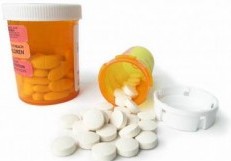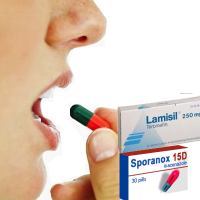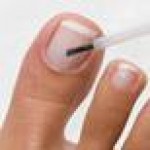Posts Tagged ‘topical medication’
Curing Toenail Fungus with Prescription Drugs
Curing Toenail Fungus with Prescription Drugs
 Thanks to the advancements of modern medicine, curing toenail fungus with antifungal prescription medicines has become quite regular. As this is an infection that can spread easily, both throughout a person’s nails and through a populous, treating it has become of higher concern than it used to be.
Thanks to the advancements of modern medicine, curing toenail fungus with antifungal prescription medicines has become quite regular. As this is an infection that can spread easily, both throughout a person’s nails and through a populous, treating it has become of higher concern than it used to be.
What does an infected toenail look like?
The first and most common symptom to develop is a whitish or yellowish spot on your nail. Gradually this will cover your entire nail and you may eventually develop dark yellow and brown spots on the nail. Your nail will become thick and brittle as the fungus burrows deep into and underneath the nail on its quest to spread.
Infection occurs when people are exposed to the spores of the fungus. This can happen if you wander around barefoot, especially in areas that are particularly dirty, if your shoes are dirty or excessively damaged, and if you have particularly sweaty feet as heat and humidity are two key ingredients to a successful fungus growing environment.
Nails can become discolored due to trauma at the nail site, rubbing of the nail from the shoe and even if you have psoriasis. It is best to consult your doctor to determine what is causing the discoloration so that you can work together to come up with the best treatment.
Your doctor will take a sample of your nail and examine it under a microscope as well as have it sent to a lab for culture. The point of this exercise is to determine if it is a fungal or bacterial infection, and if it is a fungal infection, which type of fungus is it? The more you know, the more effective your treatment will be.
Topical Medications
A standard topical medication prescribed for toenail fungus infections is Ciclipirox, commercially known as Penlac. This comes as a nail polish, which needs to be applied daily to the infected nail to destroy the fungal infection. This can take several months to occur, so be patient.
Side Effects
Penlac has been known to cause skin irritation and itching where it has been applied.
Oral Antifungal Medications
Common prescriptives for eradicating toenail fungus infections are Lamisil, known as Terbinafine, Sporanox and Itraconazole. All of these drugs will run at least a twelve week course and it takes about nine months for the nail to grow out to fully replace itself.
All of these drugs come with the risk of side effects. If you suffer severe abdominal pain, headaches, dizziness or nausea, vomiting or jaundice in the skin or eyes or if your urine becomes particularly dark, you need to cease taking the medication and report this to your doctor right away.
None of these prescriptions are recommended for people with liver or heart disorders.
Thanks to the advancements of modern medicine, curing toenail fungus with antifungal prescription medicines has become quite regular. As this is an infection that can spread easily, both throughout a person’s nails and through a populous, treating it has become of higher concern than it used to be.
Prescription Treatments for Onychomycosis – A Doctor’s Recommendations
Prescription Treatments for Onychomycosis
A Doctor’s Recommendations
 Where once onychomycosis was considered solely a cosmetic problem, doctors are treating it with greater concern. Nail fungus is unattractive, yes, but it also affects the infected person’s willingness to interact with others, especially in situations where exposing the infected nail or having other people come into contact with it may make the sufferer uncomfortable.
Where once onychomycosis was considered solely a cosmetic problem, doctors are treating it with greater concern. Nail fungus is unattractive, yes, but it also affects the infected person’s willingness to interact with others, especially in situations where exposing the infected nail or having other people come into contact with it may make the sufferer uncomfortable.
Beyond the psychological and social repercussions associated with onychomycosis, the basic function of the nail is disrupted. The point of having the nail sheath (the hard part of the nail) is to act as an armor for the soft tissue beneath and to assist in how we sense and interpret the world. A foot that has an infected nail or nails may interfere with normal sensation and even the ability to walk. Add to this the possibility of a nail fungal infection allowing for what is referred to as a ‘superinfection’, the chance that other bacteria and viruses could layer themselves on top of the fungal infection and cause further harm, and it is time to fix the problem.
These are the reasons behind the medical communities more aggressive treatment of onychomycosis. On the patient side of the equation, more people are requesting treatment and mentioning the problem to their doctors earlier to nip it in the bud.
There are two basic categories of treatment for onychomycosis. Oral (by mouth) and topical (applied directly to the infected area) Which treatment your doctor chooses will depend on a variety of factors. If the lunula (white area at the base of your fingernail) is affected by either distal subungual onychomycosis or proximal subungual onychomycosis then the oral medical prescription is the method of eradication. How the patient feels about the entire process is taken into account as well. Therefore it is not uncommon to use both an oral and a topical medication in conjunction. Working the infection from both sides of the body (in and out) can be a very effective treatment.
Choosing the oral prescription medication treatment is not to be considered lightly. One of the main drawbacks of this method of fungus eradication is that all of the antimycotic (antifungal) medications available for the treatment of onychomycosis have the potential to cause liver damage. It is imperative that your doctor test your liver function before beginning a course of these drugs and it is likely that your doctor will continue to monitor your liver during the treatment. If a patient has any history of or current liver problems, an oral medication should not be taken. The patient should monitor themselves as well, telling their doctor if they experience upper abdominal pain, malaise, fatigue, or if they notice jaundice (yellowing skin or yellowing of the eyes), pale colored stools or particularly dark urine.
In the past, Griseofulvin was the only available oral prescription medication to treat onychomycosis. It did work, but not terribly well and usually came with a passel of side effects, particularly when moderate to high doses were recommended. Griseofulvin treatment also took a long time and it was common for the infection to reoccur after the treatment stopped. Fortunately a variety of options have been created since then.
Terbinafine, more commonly known as Lamisil is very effective at fighting onychomycosis caused by dermatophytes, which is the most common cause of the disease. Terbinafine is prescribed as a 250 mg pill taken once a day for six weeks for fingernail infections and for twelve weeks if treating toenails. In some cases, pulse therapy (taking a drug for a certain period of time, then giving the body time off) has been effective. A complete blood count and liver panel should be taken before this treatment is started as well as four weeks into the therapy.
Itroconazole also known as Sporanox is also commonly administered in pulse dosing. The usual treatment schedule is 200 mg by mouth once a day for one week per month over the course of three months. Itraconazole can have negative reactions with several other forms of medication so telling your doctor exactly what you are currently taking before starting treatment is a medical necessity. A liver panel should be taken before this treatment is started and four weeks into the therapy.
Fluconazole, otherwise known as Diflucan is taken once a week in either 150 or 300 mg doses until the symptoms are gone. The treatment may last up to nine months before positive results are seen. Again, this drug may have negative interactions with other medications so tell your doctor what you are currently taking to avoid this. No blood tests are required when taking fluconazole but your doctor may order them anyway.
It is most common to use topical onychomycosis prescriptions in cases that are caught early on and therefore still mild, and in conjunction with an oral medical prescription. An incredibly effective topical prescription is Ciclopirox, commercially known as Penlac. This is an 8% topical solution that is applied to the infected area once a day. While it is a safer delivery method than oral antimycotics, when used alone it only achieved a 5% success rate.
When all other methods have failed, and/or in severe cases of onychomycosis, surgery becomes an options. There are three different methods of surgical nail removal: mechanical, chemical or surgical nail avulsion (removal). The nail can be mechanically or surgically avulsed (torn off) which is done after numbing the area with a local anesthetic as it can be quite painful. This is most common when the nail has already pulled away from the nail bed. A concentrated solution of 50% urea can be used to both eradicate the infection and soften the nail for removal and can be a fairly painless process. Once the nail has been removed, keeping the area clean and dry to prevent further or re-infection is necessary.
References
Ciclopirox (Penlac) prescribing information
Fluconazole (Diflucan) prescribing information
Itraconazole (Sporanox) prescribing information
Terbinafine (Lamisil) prescribing information
Topical Medications to Treat Nail Fungus
 Topical Medications to Treat Nail Fungus
Topical Medications to Treat Nail Fungus
There are a wide variety of treatments available to cure nail fungus. Some of these treatments are oral and some are topical. Topical treatments are available as prescription, over-the-counter and natural or alternative. Most people prefer using a topical treatment to an oral medication because the topical medication has far fewer risks associated with its use.
The topical prescription medication Penlac (otherwise known as Ciclopirox) is a relative newcomer to the U.S. market. Approved by the FDA in 1999 and in Canada in 2004, this was a wonderful improvement in the treatment of nail fungus as up until then, prescription treatments were all systemic, the regimens were long, and ran the risk of damaging the internal organs.
Penlac delivers its antifungal medication in nail polish form. The main ingredient in Penlac is Ciclopirox, a broad spectrum antifungal. This medication works via its delivery method. Because the medication is painted directly onto the affected area, it has time to penetrate the nail and deliver the necessary antifungal boost to the nail bed, which is where the fungus grows. The concept of Penlac is to kill the fungus where it lives, underneath the nail, so that the infection is permanently eliminated. This avoids the necessity of taking oral antifungal medications, which work systemically (throughout the body) and have more side effects, including possible organ damage. Application of Penlac is suggested daily to the infected nail and surrounding tissue for up to 12 weeks.
In today’s modern world, you can choose from allopathic, or prescription remedies, and natural, or homeopathic remedies. The natural remedies are frequently available at your pharmacy or online. Many products are available to cure nail fungus but one of the most effective is ClearFungus. ClearFungus is available on line and comes with a money back guarantee. The website has many testimonials available for you to read. ClearFungus is a natural fungicide and its main ingredient, combined with other natural products, work together to promote healthy recovery for your skin and nails.
The natural health market has several topical products and they usually include the same basic ingredients. The difference ends up being in the price. When looking for a natural remedy, make sure you have access to the list of ingredients, whether on the product packaging or on a website. A natural remedy should include an active fungicide and preferably ingredients that encourage healthy nail re-growth and conditioning for the surrounding skin. An excellent option for a topical nail fungicide is Tea Tree Oil, which can be purchased at any health food store and many pharmacies. If you have the option, research has shown that a spray, lacquer, or heavy ointment, are all more effective than a cream.
How you choose to treat your nail fungus infection is something that you and your doctor need to decide. If you choose to go with a non-prescription product, make sure that you do your research so that you find a product that will work best for you. Remember that natural medicine is strong and can fix many problems (as it has been doing for centuries) but that prescriptive medicine is a derivative of natural medicine as many prescription cures come from a similar chemical make-up. There are times when a prescription medicine may be necessary, especially in the case of a severe infection. However you choose to treat your nail fungus, research all possible medication interactions and side effects and keep track of anything that may occur. Because no one understands your body better than you.